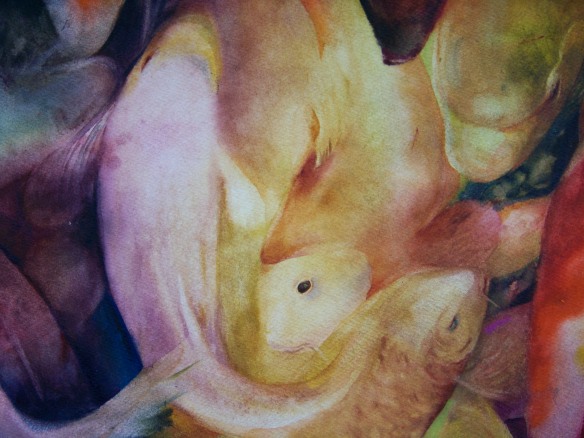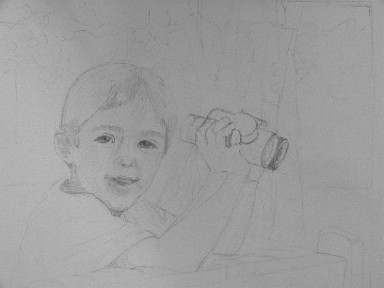22 by 22 watercolor on paper … this is just one area…. so you can see the detail. This is the third stage…
Tag Archives: WIP
day 3 tighten up the drawing
Now … here we are, after you have spent some time away from the painting look at the piece and everything that is inaccurate should be obvious, write notes to yourself, you’ll forget to change something that you’ve spotted if you rush in. If your having problem seeing the drawing ( a line drawing is very difficult for anyone to decipher) turn the drawing upside down and some things will become more obvious. Remember the line drawing is just a basic start, now you will bring the drawing together with tone or what artists call “value”
The first thing to change will be the doted lines once you decide if the shadows are correct you will put them in… There will be value that will be difficult to see, this is usually a mid value. If your unsure what the term “mid value” means… its simple, If the binoculars are the darkest item in the photo it would represent a 10 on the value scale, the face will never be more than a five on any child’s face, ( black skin is the only exception and you’ll have to keep checking back with me to see how to paint people of color) and a mid value will be about a 2.5 to 3…so when deciding your values keep this in mind. Everyone sees white and black its the values in the middle that will confuse you. As an artist, you’ll have to translate these to color and I’ll explain that when we get there. To check your values you can use cross hatching or even just smudges to place the shadows, Do not rub in the graphite as it will embed itself in the paper and give a dirty appearance to the finished product. I draw right on the paper I paint on but you may wish to draw on a translucent piece of vellum or even plain Bristol and transfer the image. This is especially good if you erase a lot. Also this image can be used again if needed as you will always have this drawing. The one on the painted surface is covered up.
If you are going to transfer the image to your board, canvas or paper use Seral transfer paper, its the best. It comes in all types of colors ( even white) but I buy gray. Its expensive but lasts forever because its reusable and if you belong to an art club you can split the expense with another artist.
Also you may wish to buy some pencils with very thin lead. ( drafting pencils are good or just a pencil with a hard lead) I’ve noticed many artists don’t realize the line of their lead is thick and this minute amount of space between the inside of the line and the outside of the line is all that may be needed to adjust an eye that is too far apart or a nostril that looks too wide. If your drawing with a hard pencil, be aware not to press into the paper too much… in fact, hold you pencil very lightly. Do not hold the pencil as you would for writing but more in a sketching manner. You will be able to give the line more character and not press so hard. For this demonstration, I have adjusted the drawing so it will show on the screen but it is actually much lighter than this on the paper. I put this drawing in a photo software program, darken it and also changed it to black and white . Graphite is more gray than black so the camera doesn’t pick it up well. Do this for most drawings you wish to put on line.
Ok lets talk about photographs
Photographs are not accurate… they are flattened so the foreshortening will be off and the values are made in bigger jumps than our eye will actually see………
1. You should meet the child/dog, or in my case Koi and(when possible )take the photo yourself. A lot of what we know about a person isn’t visual, so there is more information you can distill if you have a chance to see the child. The personailty and mannerism are missing from a photo but if you see the child you will have an emotional three dimensional aspect that you can’t substitute. Also sometimes a child will smile crooked but this isn’t their “look” you won’t know this if you only have one pphoto. If you are working from multiple photos make sure they are photos of the child at the same age and preferable all out doors and in the same season. Light is different in summer than winter and this may throw you off also if its over cast in one picture and bright sun in another you will see things differently.
2. use outdoor light
3. take color photos but change them over to black and white in a photo software program so you will have accurate values and if you want you can grid the drawing for accuracy.
Also measuring is a good way to check the distance between things,,, like the ears and the brow or the tip of the nose to the bottom of the chin. Remember when drawing, you will be drawing the outer most line then back filling with value to create the turn …so something may look too long or too wide before you put in the value. Do not change anything until your values are in place. Also in a photo the actual placement of say the hairs of the eyebrow will be difficult to see, in this case use standardized art measurements. If you don’t know what these are, write me I’ll give them to you.
Stage 3 work in Progress
This piece is 22 by 30, I have been painting each of the fish as you can see. This is basically the stage where you have to directly paint the fish while creating the three d space around each.
Nothing really to explain because this is all about your style. You paint each fish deciding what layer they will be in and you decide the colors based on the background and the surrounding fish. You paint the shadows where the Koi over lap. I started at the left hand side of the painting while trying to go around the entire piece bringing each area up a little at a time.
The gold area on the right side needs to be resolved and I’ll probably paint it brown and leave at least one Koi in the gold color, most likely two.
WIP 35 by 35 watercolor on paper Koi
Here is another shot of my wip Koi “under the falls”. I want to repaint the koi on the left, which I’ll do this week some time. This piece is 24 by 24 acrylic. Here is my newest start.. it is 35 by 35 inches
Here is my newest start.. it is 35 by 35 inches  Here is how it looks after I have wet the paper and have painted the first layer of paint.
Here is how it looks after I have wet the paper and have painted the first layer of paint.  Its pretty wet and I use towels to sop up all the water from around the sides and under the bottom.
Its pretty wet and I use towels to sop up all the water from around the sides and under the bottom. Its a long way from being complete but you can see how I start with a wet into wet underpainting. Then while its wet I pull out the fish and then when its only damp, I paint in the shadows and the parts of the fish I want softened. I have included a close up so you can see the thickness of the paint… also notice…that I don’t blend the paint. I have the paper wet on both sides on a slanted plexiglass and I tilt it and rotate it so that the colors run together to form interesting mixes. Mud will result if you over mix when its this wet and when you use so many compliments.
Its a long way from being complete but you can see how I start with a wet into wet underpainting. Then while its wet I pull out the fish and then when its only damp, I paint in the shadows and the parts of the fish I want softened. I have included a close up so you can see the thickness of the paint… also notice…that I don’t blend the paint. I have the paper wet on both sides on a slanted plexiglass and I tilt it and rotate it so that the colors run together to form interesting mixes. Mud will result if you over mix when its this wet and when you use so many compliments.  Here is a photo of one of my best friends, Sam, he loves to watch me paint.
Here is a photo of one of my best friends, Sam, he loves to watch me paint.  Check back with me again and I’ll try to take more photos as I go along.
Check back with me again and I’ll try to take more photos as I go along.



